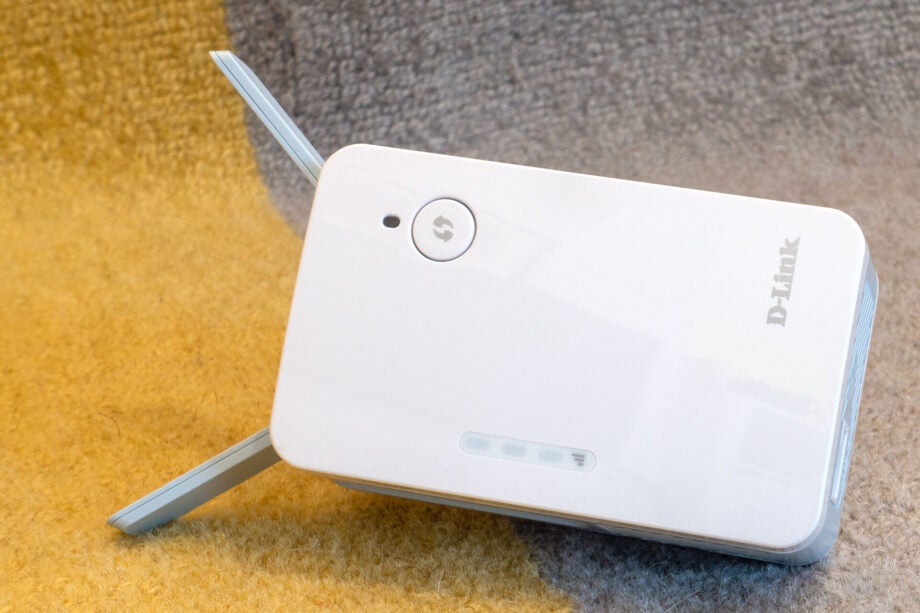D-Link E15 AX1500 Mesh Range Extender Review
A basic extender that suffered at range

Verdict
On paper, the D-Link E15 AX1500 Mesh Range Extender is a fine Wi-Fi 6 repeater. In my tests, however, it wasn’t particularly fast, and it’s light on features, too. Whatever you’re looking for, a different extender will probably suit you better.
Pros
- Compact, ergonomic design
Cons
- Disappointing speeds
- Expensive
Availability
- UKRRP: £52.99
Key Features
- Operation modesRepeater, access point, mesh
- Wi-Fi standardWi-Fi 6 (2.4GHz 300Mbps, 5GHz 1201Mbps)
- Ethernet portsOne Gigabit Ethernet
Introduction
The D-Link E15 AX1500 Mesh Range Extender extends the reach of your home Wi-Fi: plug it in a room or two away from your router and it’ll broadcast an additional network, to reach devices that are too far away to get a good direct connection.
It doesn’t claim to be the fastest extender in the business; maximum connection speeds are 300Mbits/sec on the 2.4GHz band and 1,200Mbits/sec over 5GHz, while rivals such as the TP-Link RE700X can go twice as fast. Still, the E15 supports the Wi-Fi 6 standard, which means it’ll work with the latest devices and shouldn’t slow down too much when the network gets busy.
Design and Features
- Less obstructive than other extenders
- Sensibly located WPS button and network socket
- Mesh capability for easy management and roaming
The D-Link E15 AX1500 Mesh Range Extender looks similar to many other extenders I’ve tested. However, it has the advantage of a fairly narrow design, so it doesn’t entirely block the adjacent power socket when you plug it in.

On the front there’s a big, clearly labelled WPS button, and on the underside, you’ll find a Gigabit Ethernet socket. The flip-up aerials look a bit cheap, but overall, it has a pleasingly practical design, and the three-segment signal-strength indicator is a nice touch.

You can manage the E15 from either a web portal or D-Link’s Eagle Pro AI smartphone app, but either way, there are very few settings to adjust. For example, there’s no blocklist for untrusted devices and no power schedule. All you can really do is pick a name and password for the 2.4GHz and 5GHz networks and choose whether to broadcast them under a single SSID or separate names.

If you have a D-Link Eagle Pro router, you don’t even need to do this. Enable mesh mode at the router and it will automatically detect the E15 and provision it as an access point with the same settings as your main network. Devices can then “roam” between the two, dynamically switching their connections to the stronger signal.
Performance
- Beneficial in most of our tests but not always massively so
- Downloads were actually slower in one location
For testing, I paired the D-Link E15 with its stablemate – a D-Link R15 Eagle Pro AI router. The former provides fast downloads at short range, but the connection can become slow and patchy once you move a few rooms away.
Installing the E15 in the hallway at the centre of my home certainly made a difference. Without the extender, the R15 had been averaging download speeds of 41Mbits/sec in the bedroom; the E15 boosted this to 160Mbits/sec.
Sadly, that strong performance wasn’t kept up in other rooms. In the kitchen, my download speeds only went up from 44Mbits/sec to 57Mbits/sec, while the bathroom saw an even smaller rise, from 28Mbits/sec to 35Mbits/sec.
The worst result was in the living room, where switching from the R15 network to the E15 actually caused speeds to fall from 122Mbits/sec to 60Mbits/sec. To be fair, we’ve seen similar results from other pricier products, but the best extenders can elevate performance throughout the house. For example, the TP-Link RE700X served up 218Mbits/sec in the exact same location.
Even leaving that black mark aside, the E15’s overall performance was a letdown. It did give us faster wireless, but in most locations, the benefit wasn’t significant enough to be noticeable.
Latest deals
Should you buy it?
If you have a D-Link Eagle Pro router and like the idea of a zero-management mesh, this extender could be the right choice.
If you’re looking for a big improvement in Wi-Fi performance and coverage, there are better alternatives.
Final Thoughts
On paper, the D-Link E15 AX1500 Mesh Range Extender is a good-enough Wi-Fi 6 extender. However, in my tests, it didn’t do as well as the competition. Depending on your needs, you’ll be better off choosing either the cheaper Mercusys ME30 or the faster TP-Link RE700X. Alternatively, there are other choices on our list of the best Wi-Fi extenders.
How we test
Unlike other sites, we test every wireless router we review thoroughly over an extended period of time. We use industry standard tests to compare features properly. We’ll always tell you what we find. We never, ever, accept money to review a product.
Find out more about how we test in our ethics policy.
Used as our main wireless router for the review period
We throughput test all wireless devices using the same equipment in the same locations so that we have accurate comparisons
FAQs
It needs to be paired with a D-Link Eagle Pro router.
This is a Wi-Fi 6 extender.



